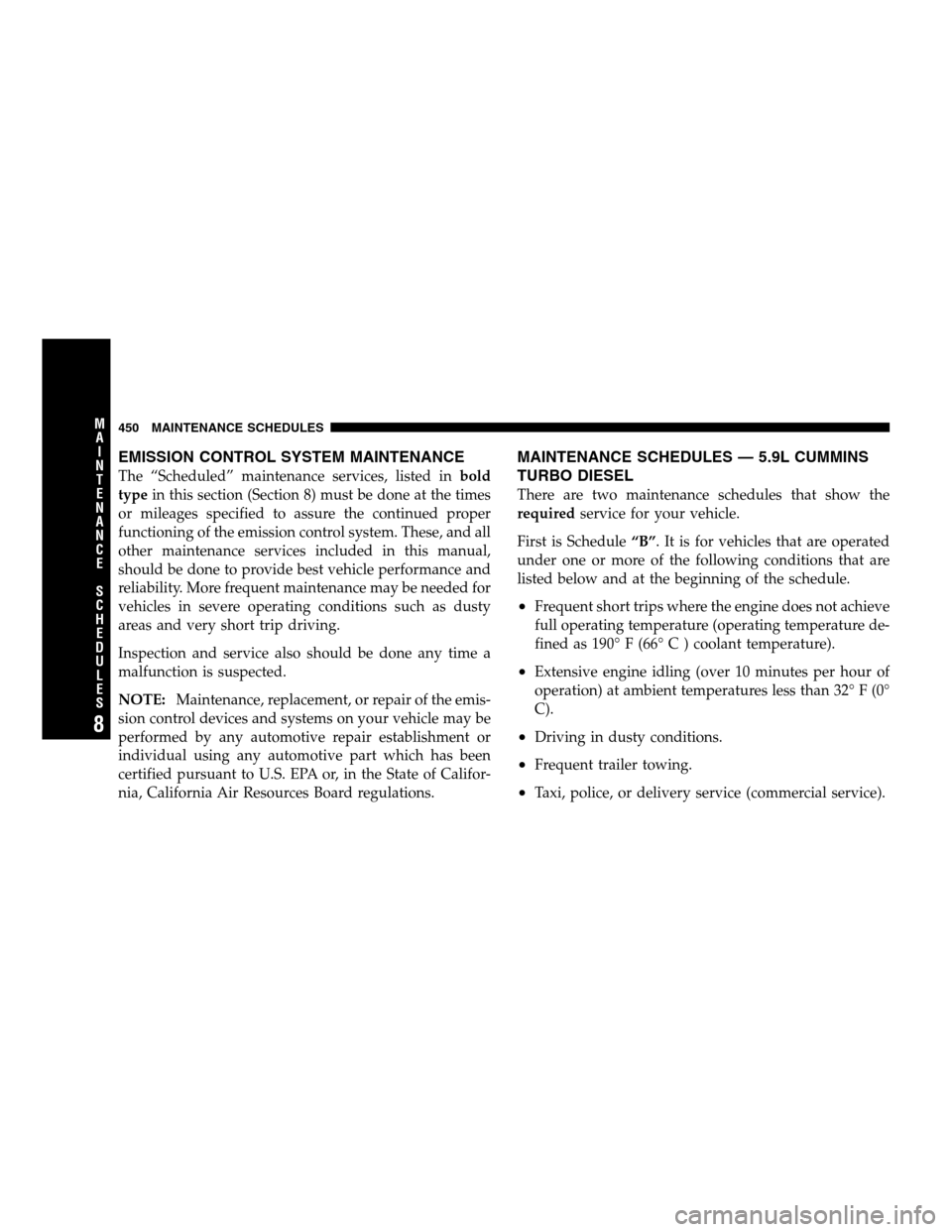Page 417 of 496
Noise Control System Required Maintenance &
Warranty
For 3500 Two-Wheel Drive and Four-Wheel Drive mod-
els over 10,000 lbs. (4 535 kg) Gross Vehicle Weight
Rating.
All vehicles built over 10,000 lbs. (4 535 kg) Gross Vehicle
Weight Rating and manufactured for sale and use in the
United States are required to comply with the Federal
Government’s Exterior Noise Regulations. These vehicles
can be identified by the Noise Emission Control Label
located in the operator’s compartment.
Required Maintenance For Noise Control Systems
The following maintenance services must be performed
every 6 months or 6,000 miles (9 600 km), whichever
comes first, to assure proper operation of the noise
control systems. In addition, inspection and service
should be performed anytime a malfunction is observed
MAINTAINING YOUR VEHICLE 417
7
Page 418 of 496

or suspected. Proper maintenance of the entire vehicle
will help the effectiveness of the noise control systems.
Exhaust System
Inspect the entire exhaust system for leaks and damaged
parts. Devices such as hangers, clamps, and U-bolts
should be tight and in good condition. Damaged compo-
nents, burned or blown out mufflers, burned or rusted
out exhaust pipes should be replaced according to the
procedures and specifications outlined in the appropriate
service manual.
Air Cleaner Assembly
Inspect air cleaner housing for proper assembly and fit.
Make certain that the air cleaner is properly positioned
and that the cover is tight. Check all hoses leading to the
air cleaner for tightness. The air filter element must also
be clean and serviced according to the instructions out-
lined in the Maintenance Schedule Section of this
manual.Tampering With Noise Control System Prohibited
Federal law prohibits the following acts or the causing
thereof: (1) the removal or rendering inoperative by any
person, other than for purposes of maintenance, repair, or
replacement, of any device or element of design incorpo-
rated into any new vehicle for the purpose of noise
control prior to its sale or delivery to the ultimate
purchaser or while it is in use, or (2) the use of the vehicle
after such device or element of design has been removed
or rendered inoperative by any person.
Among those acts presumed to constitute tampering are
the acts listed below.
•AIR CLEANER
�Removal of the air cleaner.
�Removal of the air cleaner filter element from the air
cleaner housing.
�Removal of the air ducting.
418 MAINTAINING YOUR VEHICLE
Page 420 of 496
Maintenance Log and Service Chart — 24 Valve Cummins Turbo Diesel
Noise Systems Maintenance Chart and Service Log — Insert Month, Day, Year under column mileage closest to
the mileage at which service was performed.
MILES 7,500 15,000 22,500 30,000 37,500 45,000 52,500 60,000
KILOMETERS 12 000 24 000 36 000 48 000 60 000 72 000 84 000 96 000
Exhaust system-
inspect
Air cleaner
assembly-inspect
ODOMETER
READING
PERFORMED BY
PERFORMED AT
420 MAINTAINING YOUR VEHICLE
Page 421 of 496
Noise Systems Maintenance Chart and Service Log — Insert Month, Day, Year under column mileage closest to
the mileage at which service was performed.
MILES 67,500 75,000 82,500 90,000 97,500 84,000 105,00 112,500
KILOMETERS 108 000 120 000 132 000 144 000 126 000 156 000 168 000 181 000
Exhaust system-
inspect
Air cleaner
assembly-inspect
ODOMETER
READING
PERFORMED BY
PERFORMED AT
MAINTAINING YOUR VEHICLE 421
7
Page 431 of 496

VEHICLE STORAGE
If you are storing your vehicle for more than 21 days, we
recommend that you take the following steps to mini-
mize the drain on your vehicle’s battery:
•Disconnect the Ignition-Off Draw fuse (I.O.D.) fuse
located in the Integrated Power Module, located in the
engine compartment. The I.O.D. cavity includes a
snap-in retainer that allows the fuse to be discon-
nected, without removing it from the fuse block.
•The electronic shift transfer case should be placed in
the 4HI mode and kept in this position to minimize the
battery drain.
•As an alternative to the above steps you may, discon-
nect the negative cables from both batteries.
•Anytime you store your vehicle, or keep it out of
service (i.e. vacation) for two weeks or more, run the
air conditioning system at idle for about five minutes
in the fresh air and high blower setting. This will
insure adequate system lubrication to minimize the
possibility of compressor damage when the system is
started again.
NOTE: When reinstalling the IOD fuse push firmly until
fully seated, the gages in the Instrument Cluster will do
a full sweep, when the ignition key is cycled to RUN. This
is a normal condition.
MAINTAINING YOUR VEHICLE 431
7
Page 446 of 496
FLUIDS, LUBRICANTS AND GENUINE PARTS
Engine
Component Fluids, Lubricants and Genuine Parts
Engine Coolant Mopar �Antifreeze/Coolant 5 Year/100,000 Mile Formula HOAT (Hybrid Or-
ganic Additive Technology) or equivalent.
Engine Oil For the proper quality and SAE Grade oil for your engine, refer to the section � Maintenance Procedures.�
Engine Oil Filter Mopar �Engine Oil Filter, P/N 05083285AA or equivalent.
Engine Fuel Filter Mopar �Fuel Filter, P/N 05015581AB or equivalent.
Fuel Selection Use good quality diesel fuel from a reputable supplier. For most year-round service, No. 2 diesel fuel meeting ASTM specification D-975 will provide
good performance. This vehicle is fully compatible with biodiesel blends
up to 5% biodiesel meeting ASTM specification D-975. (See page 318 for
more information.)
446 MAINTAINING YOUR VEHICLE
Page 450 of 496

EMISSION CONTROL SYSTEM MAINTENANCE
The “Scheduled” maintenance services, listed inbold
type in this section (Section 8) must be done at the times
or mileages specified to assure the continued proper
functioning of the emission control system. These, and all
other maintenance services included in this manual,
should be done to provide best vehicle performance and
reliability. More frequent maintenance may be needed for
vehicles in severe operating conditions such as dusty
areas and very short trip driving.
Inspection and service also should be done any time a
malfunction is suspected.
NOTE: Maintenance, replacement, or repair of the emis-
sion control devices and systems on your vehicle may be
performed by any automotive repair establishment or
individual using any automotive part which has been
certified pursuant to U.S. EPA or, in the State of Califor-
nia, California Air Resources Board regulations.
MAINTENANCE SCHEDULES — 5.9L CUMMINS
TURBO DIESEL
There are two maintenance schedules that show the
required service for your vehicle.
First is Schedule “B”. It is for vehicles that are operated
under one or more of the following conditions that are
listed below and at the beginning of the schedule.
•Frequent short trips where the engine does not achieve
full operating temperature (operating temperature de-
fined as 190° F (66 ° C ) coolant temperature).
•Extensive engine idling (over 10 minutes per hour of
operation) at ambient temperatures less than 32° F (0°
C).
•Driving in dusty conditions.
•Frequent trailer towing.
•Taxi, police, or delivery service (commercial service).
450 MAINTENANCE SCHEDULES
8
M A I
N T
E
N A
N C E
S
C
H E
D
U L
E
S
Page 453 of 496
Schedule “B”
Follow schedule “B” if you usually operate your vehicle
under one or more of the following conditions.
•Frequent short trips where the engine does not achieve
full operating temperature (operating temperature de-
fined as 190° F (66 ° C ) coolant temperature).
•Extensive engine idling (over 10 minutes per hour of
operation) at ambient temperatures less than 32° F (0°
C).
•Driving in dusty conditions.
•Frequent trailer towing.
•Taxi, police, or delivery service (commercial service).
•Off-road or desert operation.
•Extensive operation at high engine speeds (greater
than 2900 rpm) and loads (greater than 70% throttle).
NOTE: IfANY of these apply to you then change your
coolant every 101,250 miles (162 000 km) or 60 months,
whichever comes first and follow schedule “B” of the
� Maintenance Schedules �section of this manual.
SCHEDULE “B” 453
8
M
A I
N T
E
N A
N C E
S
C
H E
D
U L
E
S